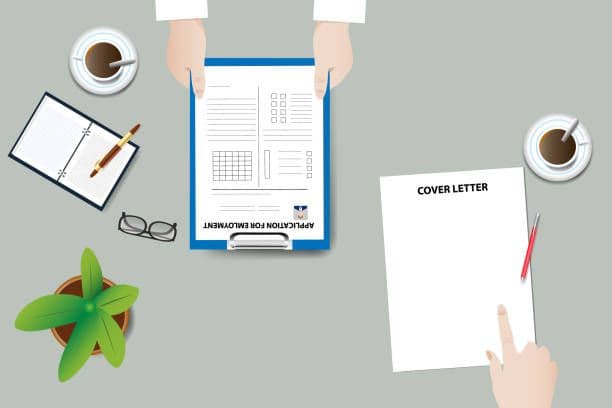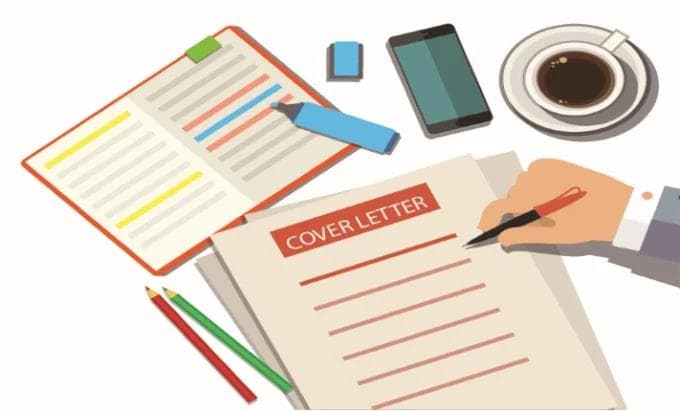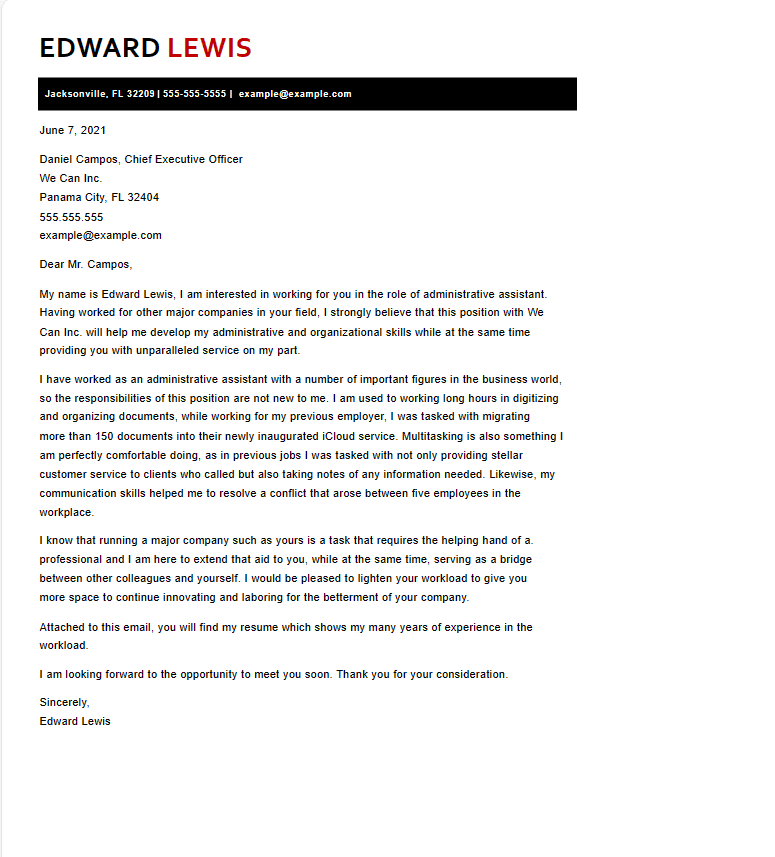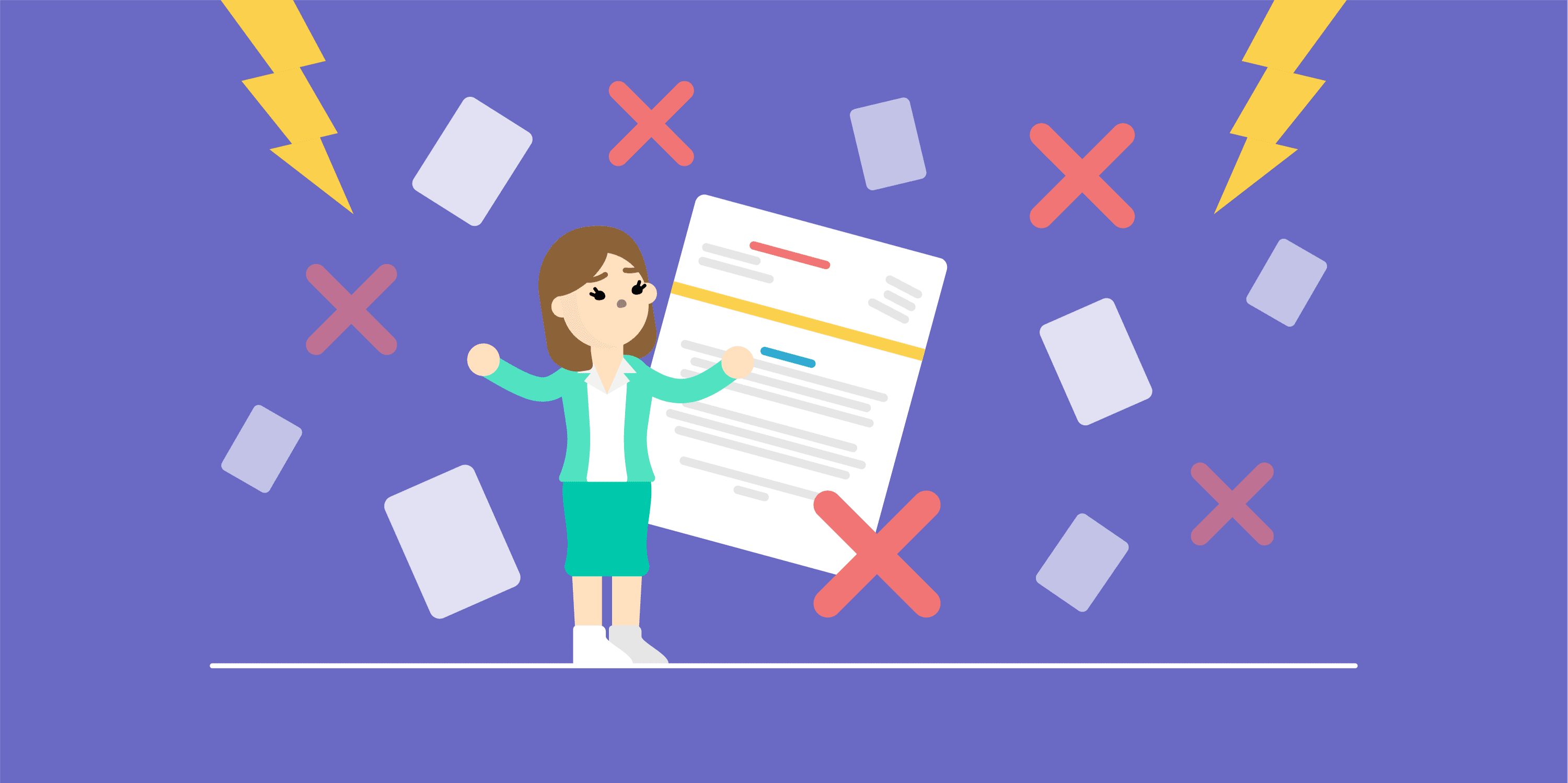The cover letter is an indispensable document if you want to appear as a professional candidate in the eyes of an employer. Alongside having a professional resume, this is the means to help you stand out among thousands of other job applications. So, what exactly is a “Cover Letter”? How can you create a professional cover letter that makes a lasting impression on the employer from a first glance? In this article, Rapid Resume will answer the basic questions you need to know about cover letters and provide you with the most useful “tips and important notes” for your application process.Let's dive in!
 Basically, the structure of a cover letter includes the following parts:
Basically, the structure of a cover letter includes the following parts:
 To prove that you are a potential candidate for the open position are being recruited. Make sure that your cover letter is carefully cared for from inside to outside, from the content to outlook, especially with the errors listed below, which should be limited in any circumstances.
To prove that you are a potential candidate for the open position are being recruited. Make sure that your cover letter is carefully cared for from inside to outside, from the content to outlook, especially with the errors listed below, which should be limited in any circumstances.

1. What Is a Cover Letter?
To put it simply, a "cover Letter" is a letter from the candidate ( attached with their resume) sent to the employer to express his or her desire to apply for a specific job position or company. In other words, this is a letter that allows candidates to highlight points that they think will benefit their job application process.Through the job application, the employer will have the opportunity to understand more about the candidate through two aspects: "Their work and their personality." In the application letter, you should not only highlight your achievements and professional skills but also your interest and goals for the position you are applying for. Besides, knowing how to use the letter skillfully to express your own personality and qualities is also considered extremely important. An excellent cover letter will demonstrate the difference and ability of the candidate as to why employers should choose them.These are the most common types of cover letters in 2024.- Application cover letter
- Referral cover letter
- Internal cover letter
- Letter of interest
- Prospecting cover letter
Why Should You Need to Write a Cover Letter?
A cover letter is much more than just a formality or a courtesy – it's an opportunity to help you make an impression. If a resume is a way for you to demonstrate your skills and expertise, a cover letter helps you demonstrate your suitability for the job position. A cover letter provides employers with detailed information about how you contribute your talents to the company, why you want to work in this position and how you are a good fit for this role.Try to show a connection between your abilities and the job description so that you can meet the requirements of the position. The cover letter is usually written in one A4 page in length. A well-written cover letter will show the employers:Your Values
A concise and compelling cover letter is your first chance to stand out and be considered a strong candidate in the tough competition. By immediately emphasizing your main strengths will help demonstrate your value, attract the reader's attention and increase your chances of being selected.Your Suitability for the Position
A cover letter is also a way to show in more detail that you have the skills, knowledge and experience that meet the key requirements of the job description.Your Quality
The wording of your cover letter can show off your personality in a way that your resume cannot. The tone of your letter gives the employer insight into your personality.Your Enthusiasm
A cover letter is considered compelling when you have taken the time to research the company and understand the employer's needs and job requirements. This is how you show your enthusiasm for the role and demonstrate the value you will bring to the employer.Do Employers Read the Cover Letter?
In many cases, the cover letter is considered as optional because some companies do not have this requirement on their candidates. However, even though it is clearly stated as “Optional”, it means it is okay that you do not submit ones.However, Rapid Resume still encourages you to invest time in creating a professional and passionate cover letter. When the Cover Letter is “labelled as Optional”, it also means that the candidate who submits it will have an advantage, proving that he or she is interested in the job and more invested in the recruitment process. And you could believe that the employer would definitely read it.2. How To Structure Your Cover Letter

- Header with date and contact information
- Salutation or greeting
- Opening paragraph
- Middle paragraphs
- Closing paragraph
- Complimentary close & signature
1. Date and Contact Information
In this part, you will need to provide your contact information and the name of the person you are sending your application letter to. Usually, it could be the head of human resources, heads of departments, or the recruitment staff who directly contact you.- Date
- Your name
- Your address
- Your phone number
- Your professional email address
- Name of recipient
- Title of recipient
- Company name
- Company address
2. Salutation /Greeting
In your research, try your best to find the name of the recruiter by rereading the job description, checking the company website, or even using your network (if possible). Because the purpose of the letter is to be sent to a specific person. If you can't write it separately or customize it, then you can ONLY think of the option of writing it in a general but formal way. When you are not able to find the recruiter manager's name, just go ahead with a common business greeting such as “Dear Hiring Manager.” But remember to avoid using "To whom it may concern."3. Opening Paragraph
Start the first part of your cover letter by mentioning the job position the company is hiring for and the source where you found the job posting. Remember to enthusiastically tell the employer why you’re applying for the job. You’ll want to make this paragraph specific to each job listing you apply for. Also, include why you’re excited about the job and the company and how the job lines up with your career goals to show you’ve done your research. This information will attract employers and build their first impression of you. Put yourself in the reader's position and consider which main information you want to mention.4. Middle Paragraphs
If the employer is attracted by your opening statement, then they will continue reading to learn more about you. This is also the main part and backbone of the cover letter. You need to be more specific about your work experience and skills relevant to the position you are applying for. If possible, showing them how knowledgeable you are about their company or products is also a plus.However, you do not need to fully state and detail your previous work history and all your skills as in your resume. Remember to be brief, get straight to the point, and list out the connections from your previous accomplishments that you can bring to this position.Just simply think of these paragraphs as a way to pitch yourself as the ideal match for the role. Employers will likely have read your resume already, so avoid repeating the points. But instead, only include the key details that are going to deeply illustrate those highlights because this is also considered as the plus point that will make you as a bright "candidate" in the eyes of the recruiters.In short, employers usually only spend about a minute skimming through a candidate's cover letter, so make sure your application letter is presented concisely and succinctly but still provides all the necessary information.5. Closing Paragraph
Before finishing the application, always express your appreciation to the employer for reviewing and evaluating the application and considering you for the job position. They take time out of their day to read the message you've written. That’s why expressing gratitude and appreciation for the employer's efforts is a gesture that shows your politeness and professionalism.Right after that, call them to action, which is to invite you to an interview. In sales, there are very popular “Call To Action” concepts such as "Try - Try now", "Call me - Call now", and "Free trial”, and it should be the same goes for applying for a job.You can reemphasize once again why you chose to apply for this job opening, why the employer should choose you among the many potential candidates out there, and what you can bring to the table. Also, show the employer that you are looking forward to a face-to-face interview so you can discuss more deeply about yourself and your career aspirations.6. Complimentary Close and Signature
Choose a complimentary closing that is friendly yet formal, followed by your first and last name. Closings you might consider should be referred to:- Sincerely,
- Best Regards,
- Respectfully
Cover letter format example
Here is a simple cover letter format example that might give you a general idea of how to write a cover letter for your next job application. Check it out below!
3. Things to Take Note When writing a Cover Letter
So, what should you pay attention to when writing a cover letter that is highly appreciated in the eyes of the employer?Present Concisely, Succinctly
Similar to a resume, a cover letter should only be presented briefly so that the employer can easily grasp all the most important content in just the first minute. However, you should also make sure that you have included all the necessary information.File Format
You can export the cover letter file and send it to the employer via hard copy or soft copy. However, for soft documents sent online, Rapid Resume always encourages you to use PDF file format to avoid font errors if the recruiter opens the file with incompatible browsers. Also, because an applicant tracking system may be parsing your cover letter, so that is the reason why saving it in PDF is an ideal choice.Font
Fonts also play an important role in the design of the cover letter. To make your cover letter more readable, you should refer to some common but simple fonts such as Arial, Times New Roman, Calibri, Tahoma... and consider using them consistently throughout your application letter.Show Sincerity
You can easily find a sample cover letter everywhere online when you search for keywords about them on Google. However, don't be too mechanical and turn your cover letter into a dry and impersonal document. Carefully write down every word in your cover letter that shows your sincerity and progress, as well as shows your deep interest in the job. It also proves that you should be the one to be chosen among hundreds of potential candidates out there.Experience, professional skills, and qualifications are all necessary factors, but attitude is also one of the deciding factors. Therefore, pay attention to the style, words, and tone of voice you use throughout your application.It can be said that writing a job application letter is not too difficult. The important thing that you need to pay attention to here is the carefulness and meticulousness of your letter. Hopefully, with the above sharing, you will understand how to write a better cover letter and can open yourself up to future interview doors.If you want to have a standout resume attached to your professional cover letter, then this is blog is exactly what you NEED to know to win that job offer: 7 Ways to Make Your Resume Stand Out from the Crowd
4. Mistakes to Avoid When Writing Cover Letters

